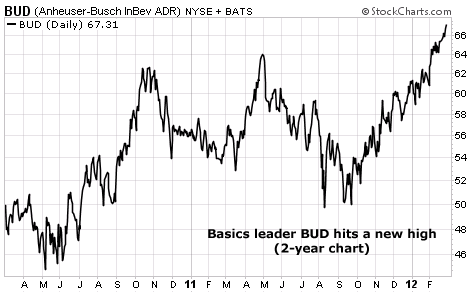| Home | About Us | Resources | Archive | Free Reports | Market Window |
How to Secure a SAFE Double-Digit Income Stream in RetirementBy
Thursday, March 1, 2012
In yesterday's essay, I revealed an unusual investment technique my readers use to regularly generate 10%-20% income streams on their retirement savings.
Reader feedback tells me this strategy is a godsend for folks who thought they had to settle for the tiny yields of conventional CDs and bonds.
This strategy is called "selling covered calls."
If you're not familiar with this strategy, I encourage you to read yesterday's essay. For many folks, learning this strategy (and other safe option strategies) is like walking out of a dark cave and into the sunlight. I know it was for me when I learned it years ago working for Goldman Sachs.
Over the years, I've taught this technique to friends, family members, and readers. Each time I teach it, I urge folks to keep in mind a key factor that ensures they collect not just double-digit yields on their savings... but SAFE double-digit yields...
That key is to use this strategy on the world's safest, best stocks... especially stocks that "prove" their worth to shareholders by paying steadily increasing dividends.
You see, many people make the mistake of using the market's riskiest stocks in their covered call programs.
Remember, in a covered call position, you're receiving cash upfront for agreeing to sell your shares at a higher price sometime in the future. The reason people gravitate toward selling covered calls on risky stocks is simple: You can collect more money upfront.
Risky stocks – like a high-growth restaurant chain or a mining stock – are more volatile than blue chips like Intel or Johnson & Johnson. Since option prices are greater on volatile stocks, the "cash upfront" on covered call payments are larger.
Thus, many people buy risky stocks, sell covered calls against them, and think they're going to make a fortune. They might collect a 10% premium by selling a call option, but when something goes wrong with their risky stock, it plunges 25%. The whole position results in an overall loss of 15%.
I don't like losing. And I certainly don't want to see a stock in my retirement account go down 25% in a short time.
That's why, when it comes to selling covered calls, I stick to shareholder-friendly, dividend-paying stocks. I'm talking about stocks like Johnson & Johnson, Intel, and Microsoft. These companies dominate their industries, have reliable cash flows, and pay consistently rising dividends.
While there's no guarantee these blue chips won't decline in price, they are the steadiest stocks in the world. Last summer, for example, these basic dividend-payers "sailed" through the market panic. While many riskier stocks fell by 25%-50%, blue-chip dividend-payers held steady.
Most stock investors were panicking. Meanwhile, anyone who held a covered call position in safe blue-chip dividend-payers could simply sit back, collect dividends and cash premiums, and sleep well at night.
And safe dividend streams act as a "magnet" that draws share prices higher over the long term. An index of the world's best dividend-payers is well over its 2007 highs... while the benchmark S&P 500 stock index is still well below its peak.
Many retirees can't afford to settle for the meager yields offered by regular CDs and bonds. They need to collect a larger income stream, and unconventional investments like covered calls can help... But you don't want your investments to keep you up at night.
By centering your covered call strategy around reliable, blue-chip, dividend-paying businesses, you get the best of both worlds.
Here's to our health, wealth, and a great retirement,
Doc Eifrig
Further Reading:
You can earn a 2.5% annual yield on a dividend-payer like Microsoft. Or you can make 14% in one year using Doc's covered call strategy. This trade isn't just theory... His readers have booked safe, double-digit gains again and again through blue-chip dividend-payers like Microsoft. Read more about how this strategy can boost your income here: Before You Buy Another CD or Bond, Make Sure to Read This.
Market NotesSELLING THE BASICS: THE BEER EDITION Selling "the basics" isn't just working for cigarette companies... it's working for brewers as well.
Regular readers know that when it comes to investing in high-growth emerging markets like Brazil, India, and China, we avoid hot gadgets and Internet stocks. We recommend "the basics" approach of owning dominant global companies that sell things like soda, beer, and cigarettes to these markets. "Boring" products like these enjoy steady demand. After all, there's scant risk new technology will make having a beer after work obsolete. Plus, well-run companies in these industries generate huge cash flows and dividends.
We often point to giant cigarette-maker Philip Morris International (PM) as one of the best "basics" firms you can own. The stock is a favorite of our colleague Dan Ferris. It has confirmed our basics thesis by registering a 100% return in the past two years.
Today's chart shows the basics approach is also working for another one of Dan's favorite companies... global brewing giant Anheuser-Busch InBev (NYSE: BUD). BUD owns many of the dominant brands in the U.S... and it has a huge "footprint" in many of the world's fastest growing economies. Thanks to its dominant, steady business model, BUD shares have gained 80% in the past two years. And just yesterday, the stock struck a new all-time high. We state again: Selling the basics isn't sexy... but it works!
 |
In The Daily Crux
Recent Articles
|


